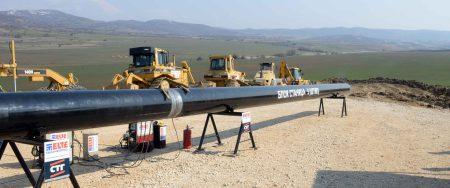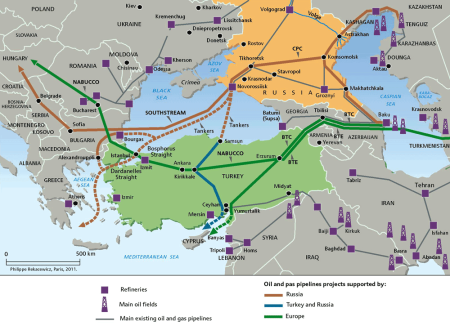 Culture FoundationONLINE JOURNAL Pyotr ISKENDEROV Strategic-Culture.org |
Russia’s Stroytransgaz has announced that it will build a gas pipeline across (FYR) Macedonia, which could eventually be used as part of a route to supply Europe with Russian gas via Turkey. Macedonia will have its own source of energy. Today the country has energy dependence indicator of 47, 9 percent – the second largest after Croatia (52%). The importance of the pipeline going across Macedonia is immense. It will become the key component of all-Balkans energy system linked to the Russia-Turkey joint Turkish Stream project on the construction of gas route leading to Central and South Europe.
According to Stroytransgaz, the 96.6 km (60 miles) Negotino-Klecovce gas pipeline will cross Macedonia from near the Greek border in the south up to the vicinity of the Serbian border in the north. Stroytransgaz will build 61 km of the link by June 2016.

At the moment, Macedonia receives gas from Russia via Bulgaria and Romania as part of the transit through Ukraine (pipe string N8). The existing pipeline has a capacity of 800 million cubic meters a year – not enough to satisfy the needs of the Balkans. The pipeline may be out of operation as early as 2019 when Russia plans to stop using this route, or, even earlier, in case of Ukraine’s further disintegration.
Gasprom and its Turkish partners want to finish the construction as early as they can. Gazprom’s CEO Aleksey Miller said, «Our priorities – to study the route’s options in Turkey, to define the location of the landfall facilities, gas delivery points for Turkish consumers and border crossings between Turkey and Greece».
There is an intriguing collision here. Nature and geography are the factors to facilitate Macedonia’s becoming the key transit country in the Balkans. There is an alternative route going through Bulgaria and Serbia. But Moscow does not see Bulgaria as a partner to trust. Serbia imports all the gas it consumes. Russia accounts for 95% of its supplies. Belgrade faces political problems. It has to prove itself as a reliable partner to become part of the emerging energy system in the Balkans.

Turkish Stream has the same capacity as South Stream. It can carry up to 63 billion cubic metres (bcm) of gas annually to Europe with 16 billion remaining in Turkey and 47 billion going farther to the Balkans. It’s enough to satisfy all the requirements. The main obstacle is the gap between the Serbia’s ruling elite on the one hand, and the interests of Serbian people on the other.
No matter Western and many Serbian media outlets have launched an anti-Russian and anti-Gasprom campaign, there is a growing understanding in Serbian society of the reasons South Stream was cancelled. According to a poll conducted in late 2014-early 2015, 39, 8% of Serbs believe the United States is behind the cancellation of South Stream while 20,2% put the blame of the European Union. Only 6, 5% believe that it was Russia’s fault. 2, 4% of respondents think that Bulgaria was responsible because it’s not fully independent while taking decisions on energy and other issues.
Bulgaria mainly, and to lesser extent Serbia, failed to act on their own being too much subject to foreign influence. Today Turkey imports around 70% of oil and gas it needs, its consumer demand is to increase 40% by 2020. Turkey wants to become a key energy hub. It takes part in talks on all the projects under consideration related to new routes going to Europe, no matter some of them are subject to competition. The availability of resources defines energy geopolitics. It makes the Russia’s position be on solid footing.
Of course, Macedonia presents some risks due to internal political instability and the emergence of Albanian factor. The West’s intention to frustrate the Russia’s plans is obvious. There are grounds to believe that the recent round of political confrontation in Skopie was incited by the West. The events have all the making of «color revolution» inspired from outside. But one way or another, Serbia, Bulgaria and Macedonia have to think about their energy needs. Common reason makes them realize that close cooperation with Russia meets their interests. All planned and existing energy routes go to the region from the East, not from the West. Liquefied gas tankers from Qatar or Algeria don’t drop anchors Belgrade, Sophia or Skopie.

